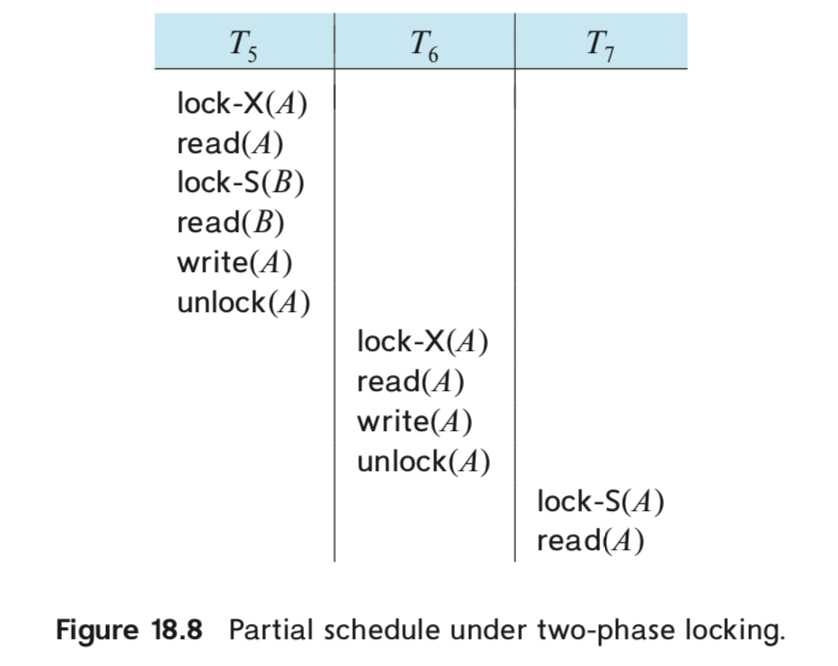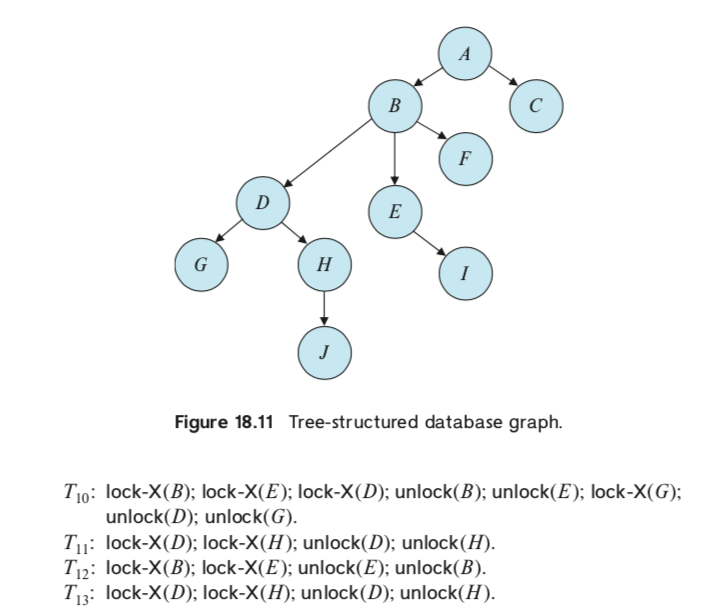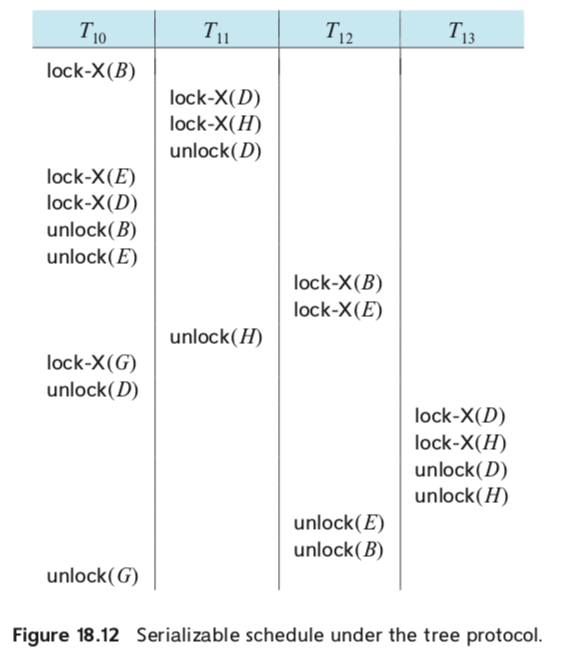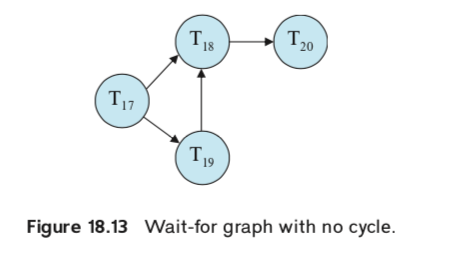Transaction Concurrent Control

多数场景下,数据库(DB)是一个共享资源,用户从DB中有序获得数据资源。早期的DB,一次只能服务一个用户请求,不同客户的请求按照一定的顺序在服务端进行一系列的Transaction(Txn)事务处理,这样每个用户端的用户在其被服务的时间内独享整个DB资源。由于单个用户占用DB的行为和时间不定,会造成其他用户必须等待的情况。那么如何能让更多的用户在同一时间按照一定的顺序并发访问DB呢?这是Transaction Contrrent Control的研究范围,接下来就会讨论,如何实现高并发访问DB的同时,让每一个用户有独享DB的感觉。一切要从ACID说起。
本文是基于Database System Concepts 加上自己的理解汇总而成。具体细节请感兴趣的同学自行阅读。
ACID
Atomicity:所有Txn对数据库造成的变化只有两种状态,完全应用和完全没有应用。
Consistency:数据库整体的一致性。
Isolation: 每个Txn执行期间是不会相互影响的。每一个Txn仿佛独享数据库一样。
Durability:commit的数据就应该持久化。
其中,isolation是并发的头号敌人,因为如果多Txn并发并且在Txn中操作了相同的key,这几乎是不可能不相互影响的,同时最终多个Txn最后的结果还有可能影响数据库整体的Consistency。
具体到isolation levels,SQL 有如下标准:
Serializable usually ensures serializable execution.
Repeatable read allows only committed data to be read and further requires that, between two reads of a data item by a transaction, no other transaction is allowed to update it.
Read committed allows only committed data to be read, but does not require repeatable reads. For instance, between two reads of a data item by the transaction, another transaction may have updated the data item and committed.
Read uncommitted allows uncommitted data to be read. It is the lowest isolation level allowed by SQL.
这里所有的isolation levels 都不允许dirty writes,这基本上是isolation levels 的底线。
下面我们来总结一下,要实现上诉的isolation levels,目前可以采用的方法。
Introduction to Current Control Method
要实现并发控制,最直观的方式就是使用锁,Txn执行过程中锁住整个DB就可以直接实现serializable了,最严格的isolation level。但是这样会极大的浪费资源,由于用户释放锁的时间不定,相当于庞大的DB资源只为一个用户使用。更一步的改进是,Txn中对要获得的资源上锁。Two-phase locking 就是这样的lock protocol。
另一种是基于timestamp的协议,read timestamp代表读过该数据的最大的时间戳,write timestamp是当前写入该数据的时间戳。如果出现冲突,通过时间戳控制每一条数据是否可以由当前 Txn 读写。
另外,目前比较流行的是Multiversion concurrency-control(MVCC),单条数据同时拥有多个修改版本。读取操作只读去某一个版本数据,不会与其他 Txn造成冲突,可以有效解决读 Txn 较多的并发场景。
Predicate locking谓词锁是另外一种比较老的并发锁,与Two-phase locking 不同的是,其锁的是SQL里面的命令动作。
Lock-Based Protocols
主要使用shared-mode lock (S) 和exclusive-mode lock (X)两种锁。需要对data进行读请求需要使用S,对data进行写请求需要使用X。S和X锁的兼容性关系如下:
| S | X | |
|---|---|---|
| S | true | false |
| X | false | true |
只有shared-mode lock 和shared-mode lock 是兼容的,也就代表同一个数据的Read-Read并发是没有冲突的。
为了避免某些Txn有可能饿死(starved),我们需要使用一定的封锁协议。
Two-Phase Locking Protocol
Two-Phase Locking Protocol是一种可以实现serializability的封锁协议。执行过程如下:
- Growing phase. A transaction may obtain locks, but may not release any lock.
- Shrinking phase. A transaction may release locks, but may not obtain any new locks.
为了避免 Cascading rollbacks 我们可以使用 strict two-phase locking protocol.
为了实现 serializability 我们可以使用rigorous two-phase locking protocol,直到txn结束才会释放所有的锁。
Example:

Graph-Based Protocols
如果我们希望不使用two phase,我们就需要知道额外Txn的附加信息。最简单的模型是我们需要提前知道txn进入db的顺序。提供这种附加的信息,就有可能构建图基于形结构的协议,仍实现serializability。
其中 tree-locking protocol 就是这样一种协议,它是无锁的,也不需要回滚。tree-locking protocol 相比于two-phase locking 的另外一个好处是由于知道并发的顺序,所以可以提前放锁。然这种协议的缺点是在某些场景下会对自己不需要访问的数据枷锁。
具体实现是,将Txn访问的顺序,按照如下规则生成一个图。
If di → dj, then any transaction accessing both di and dj must access di before accessing dj.

The first lock by Ti may be on any data item.
Subsequently, a data item Q can be locked by T**i only if the parent of Q is currently locked by Ti.
Data items may be unlocked at any time.
A data item that has been locked and unlocked by Ti cannot subsequently be relocked by Ti.

Deadlock Handling
对于使用锁的协议来说死锁是必须要处理的一个问题。一部分协议使用Deadlock Prevention的一些方法避免造成死锁,另一部分协议使用 Deaklock Detection 和 Recovery from Deaklock 的方式来解决死锁的问题。
Deadlock Prevention
避免产生死锁,总体的思路分为两种,第一种是提前知道Txn需要加的所有锁,一次性加锁,第二种是每个Txn按照一定的顺序加锁。这里讨论第二种,这种方法按照时间顺序加锁,配合回滚机制确保可以防止死锁出现。具体如何保证按时间顺序加锁,这里讨论了wait–die 和wait–die 两种方法。
- The wait–die scheme is a nonpreemptive technique. When transaction Ti requests a data item currently held by Tj, Ti is allowed to wait only if it has a timestamp smaller than that of Tj (i.e., Ti is older than Tj ). Otherwise, Ti is rolled back (dies).
The wait–die scheme is a preemptive technique. It is a counterpart to the wait– die scheme. When transaction Ti requests a data item currently held by Tj, Ti is allowed to wait only if it has a timestamp larger than that of Tj (i.e., Ti is younger than Tj). Otherwise, Tj is rolled back (Tj is wounded by Ti).
Returning to our example, with transactions T14, T15, and T16, if T14 requests a data item held by T15, then the data item will be preempted from T15, and T15 will be rolled back. If T16 requests a data item held by T15, then T16 will wait.
Deadlock Detection & Recovery from Deadlock
死锁检测主要使用 Wait-for graph 来实现。

死锁的恢复主要有一下两种方式:
-
Selection of a victim to rollback
-
Lock timeouts
Timestamp-Based Protocols
基于时间戳的协议中,Txn的时间戳时间就是实现serializability 的执行顺序。具体实现如下:
Suppose that transaction Ti issues read(Q).
If TS(Ti) < W-timestamp(Q), then Ti needs to read a value of Q that was already overwritten. Hence, the read operation is rejected, and Ti is rolled back.
If TS(Ti) ≥ W-timestamp(Q), then the read operation is executed, and R-timestamp(Q) is set to the maximum of R-timestamp(Q) and TS(Ti).
Suppose that transaction Ti issues write(Q)
If TS(Ti) < R-timestamp(Q), then the value of Q that Ti is producing was needed previously, and the system assumed that that value would never be produced. Hence, the system rejects the write operation and rolls Ti back.
If TS(Ti) < W-timestamp(Q), then Ti is attempting to write an obsolete value of Q. Hence, the system rejects this write operation and rolls Ti back.
Otherwise, the system executes the write operation and sets W-time- stamp(Q) to TS(Ti).
Validation-Based Protocols
- Read phase.
- Validation phase.
- Write phase.
Multiversion Schemes
MultiVersion Concurrency-Control(MVCC) 是目前使用的最广泛的一种并发策略。每一次对同样的数据 Q 进行更新操作会创造一个新版本的Q,Txn的读操作会选取相应版本的Q进行读取,不会与其他Txn产生冲突,所以在读Txn较多的场景可以大幅度提升性能。
Multiversion Timestamp Ordering
If transaction Ti issues a read(Q), then the value returned is the content of version Qk.
If transaction Ti issues write(Q), and if TS(Ti) < R-timestamp(Qk), then the system rolls back transaction Ti. On the other hand, if TS(Ti) = W- timestamp(Qk), the system overwrites the contents of Qk; Otherwise (if TS(Ti) > R-timestamp(Qk)), it creates a new version of Q.
Multiversion Two-Phase Locking
将Txn分为read-only transactions 和 update transactions,对于read-only transactions 直接返回相应版本的数据,对于update transactions 实行rigorous two-phase locking,也就是加锁直到Txn结束才会放锁。
MVCC GC
相同数据的不同版本需要及时做垃圾回收,垃圾回收的规则如下:
Suppose there are two versions, Qk and Qj, of a data item, and that both versions have a timestamp less than or equal to the timestamp of the oldest read-only transaction in the system. Then, the older of the two versions Qk and Qj will not be used again and it can be deleted.
Snapshot Isolation
snapshot isolation 是并发控制策略最经常使用的一种方式。在Txn执行之前提供db的快照,Txn需要的所有read,write的数据都是在这个快照上发生的,Txn最终会有validation阶段,如果没有冲突才可以提交。
跟Timestamp最大的不同点是,Timestamp是基于每一条数据做检测是否合法,而snapshot isolation 是快照级别的,validation阶段检测的也是整个Txn在快照内更新是否合法。
Multiversioning in Snapshot Isolation
Tj is concurrent with Ti if either
StartTS(Tj) ≤ StartTS(Ti) ≤ CommitTS(Tj), or StartTS(Ti) ≤ StartTS(Tj) ≤ CommitTS(Ti).
In validation step, for Write-write conflict, first committer wins.
需要注意的是snapshot isolation 并实现不了 serializability。需要额外的其他方法来保证。
Summary
为保证ACID的性质,这里介绍了各种各样的并发控制协议。主要分为locking protocol,timestamp protocol,multiversion schemes 和 snapshot isolation。这些协议都是为了不同的用户可以相互不受影响的并发访问DB。然而,并不是所有的场景下都需要实现严格的Serializable。往往牺牲一定的隔离行等级,可以换取更好的并发性能。这也是snapshot isolation 近两年特别流行的原因。